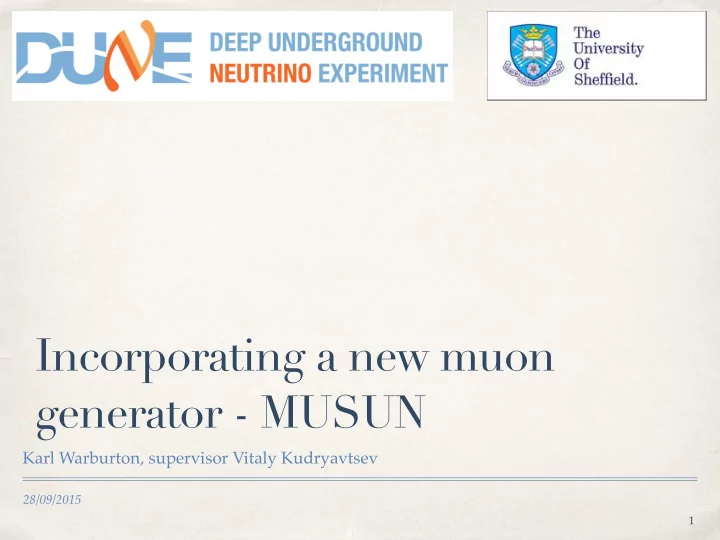

Incorporating a new muon generator - MUSUN Karl Warburton, supervisor Vitaly Kudryavtsev 28/09/2015 1
Brief overview of the generator ✤ Loads files containing already transported muons (by MUSIC) as input. ✤ These files contain muon spectra and fluxes. ✤ It then uses random number generators to ‘decide’ what θ , φ and positions to use on an event by event basis. ✤ Also calculates depth of muon using θ and φ information. ✤ Can generate muons on either surface of sphere (for cavern independent reference) or parallelepiped (for simulation), through assigning a fcl parameter — explained in MUSUN.fcl. ✤ Widely used in experiments such as LZ and also previous background studies for LBNE. 2
Acknowledgements ✤ Original MUSUN code written in fortran by Vitaly Kudryavstev (Sheffield) ✤ Conversion from Fortran to C, Kareem Kazkaz (LLNL) and David Woodward (Sheffield) ✤ Notable contributions to surface map profiling, Chao Zhang (USD) and Jeff de Jong (Oxford) ✤ Default slant depths and surface profile work, Martin Richardson (Sheffield) ✤ Incorporation into LArSoft, Karl Warburton (Sheffield) 3
How the generator works I ✤ For a detailed description I invite people to look at LBNE DocDB 9673. I will also write something for DUNE DocDB soon… ✤ Uses MUSIC, a specialised muon transportation code to propagate muons through the rock as opposed to GEANT4. No secondary particles from muons are simulated, only muon energy loss so is significantly faster than GEANT4. ✤ MUSIC considers energy loss from; ionisation (Bethe-Bloch formula), bremsstrahlung, electron-positron pair production and inelastic scattering off nuclei. 7 GeV are simulated. All muons are considered to be ✤ Muon energies of up 10 ultra-relativistic so if energy approaches the muon mass that muon is stopped. 4
How the generator works II ✤ The MUSUN code uses the output of the MUSIC stage outlined previously convolved with muon energy spectrum and angular distribution at the surface. ✤ A maximum slant depth of 15 km w.e is considered as below that the neutrino-induced muon flux has to be considered. ✤ The curvature of the Earth is considered in calculations. ✤ Changing the rock density requires recalculation of an initial depth calculation. Default value is 2.7 g cm -3 . ✤ A μ +/ μ - ratio of 1.38 is considered. This ratio is fully adjustable. 5
How the generator works III ✤ When running the generator two subroutines are called; ✤ Initialisation - called at the begin job stage ✤ Calculates differential and integrated muon intensities for a specific vertical depth. ✤ The intensity as a function of energy and zenith angle is stored in memory as a 2D array. ✤ Sampling - called for each event. ✤ Accesses the the 2D array using random number generators to select which parameters to sample. ✤ These parameters are then used to create an event. 6
Status of generator ✤ Fully functioning in LArSoft, and now incorporated into larsim - v04_24_00! ✤ I have generated 10M muons (in LArSoft) to compare to a 10M muon sample produced by Vitaly and they are broadly consistent, so little to no further work required. ✤ Also generated a 10M sample of muons for Davis lab to compare to the muons used in LZ - less important as some co-ordinate tweaks were made generating this set. 7
Understanding comparison plots ✤ A co-ordinate transformation was required to incorporate into LArSoft. ✤ Muons are simulated on the surface of a box with dimensions (in LArSoft) ✤ X Vitaly —> -Z LArSoft ✤ X… -2000 —> 2000 cm ✤ Y Vitaly —> X LArSoft ✤ Y… -1500 —> 3500 cm ✤ Z Vitaly —> Y LArSoft ✤ Z… -5000 —> 5000 cm ✤ When comparing samples, please bear these transformations in mind as positions are shown in Vitaly space, unless otherwise stated. 8
Cos ( θ ) - zenith angle Generated on a box of Generated on a box of Generated on a sphere LBNE cavern dimensions in LBNE cavern in LArSoft LArSoft dimensions by Vitaly 9
Depth ✤ Need to look at why Vitaly has a cut off at 12 km w.e which I don’t get when using LArSoft…. Generated on a sphere by Vitaly ✤ Mean slant depth is consistent though! Generated on a sphere in LArSoft 10
Comparing a range of quick identifiers ✤ Credit to Kareem and Dave, using their code to make plots. ✤ Direction cosines all look consistent, is a slight energy change, and a decrease in φ = 0… Box of LBNE cavern Box of LBNE cavern dimensions in LArSoft dimensions by Vitaly r - θ r - θ b - φ b - φ 11
Comparing θ vs φ Generated on a Generated on a sphere in LArSoft sphere by Vitaly 12
Comparing θ vs φ II Generated on a box of Generated on a box of Generated on a sphere LBNE cavern dimensions in LBNE cavern in LArSoft LArSoft dimensions by Vitaly 13
Positions - in LArSoft geometry Box of LBNE cavern dimensions 14
Conclusions ✤ MUSUN is a very powerful underground muon generator that will be extremely useful when performing far detector simulations. ✤ Now fully integrated into LArSoft (v04_24_00) ✤ A large sample has been generated in LArSoft and found to be consistent with an externally generated sample. ✤ I will write a note shortly as a guide to how to run it, but for now I invite people to look at LBNE DocDB 9673. 15
Recommend
More recommend